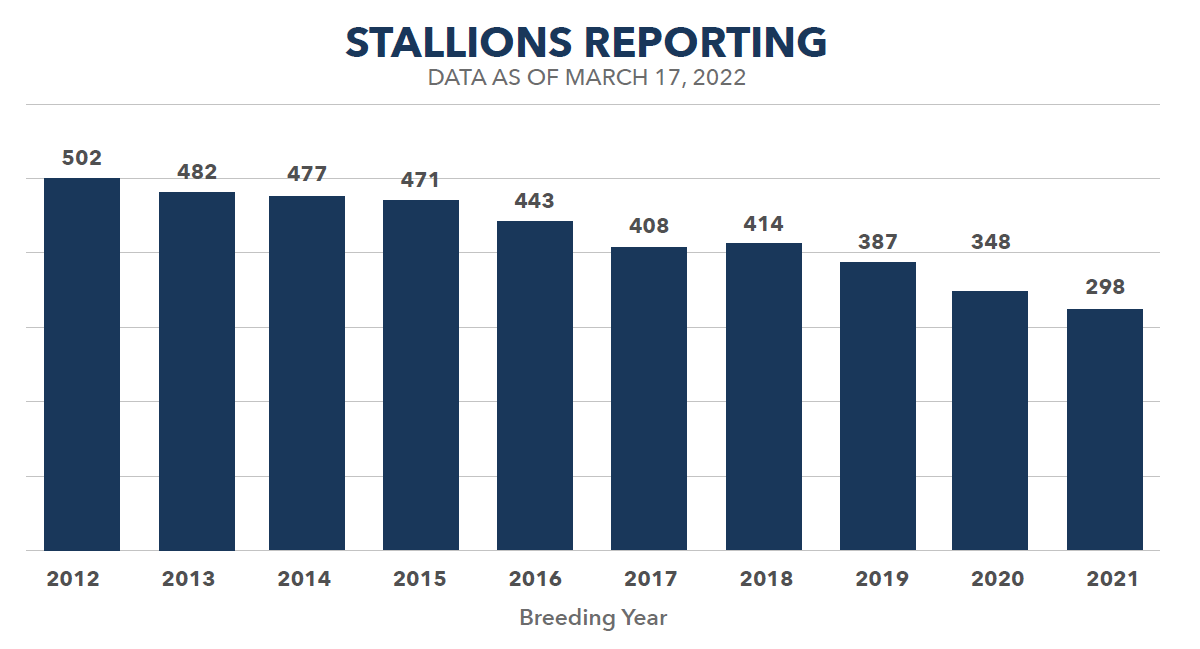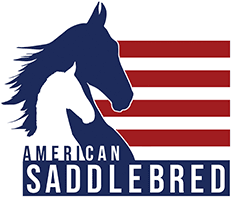
Continuing the Conversation - Options for Breeders
By Bob Funkhouser - Reprinted by permission from Saddle Horse Report - 3/21/2022
We continued the conversation last time concerning the state of the breeding industry and this piece will deal with what goes into selecting a stallion for your mare. The following questions have been asked of a variety of breeders:
- When choosing a stallion for your mare what are the attributes you are trying to get? What types are you trying to raise?
- What are your favorites – your go to bloodlines and why?
- Who do you consider the top horse you have ever raised?
Kristen Bagdasarian of Diamond View Farm, Versailles, Kentucky, manages stallions and foals out mares for several owners, including herself. Here’s what she had to say. “When I set out to breed a mare my goal is to raise the nicest show horse I can. I want to raise performance show horses. I try and breed my mares to stallions that will help their weaknesses. I like a pretty, bright, up-headed horse. We sell a lot of young horses and those are very marketable. That being said, I know every horse I raise is not going to be a Louisville quality performance horse or maybe even a show horse and that’s okay. My hope for every horse I raise is that they go on to be useful enjoyable horses in whatever they do. So, I want good thinking horses. A good thinking horse will find a job in life. To do other jobs well they need to have correct conformation as well as be trainable.
“There are so many great stallions out there to breed to right now. The Callaway Hills bloodlines of CH Caramac and Callaway’s Blue Norther will always be some of my favorites. They produced top show horses for decades and they went on to sire generations of top producing broodmares. I love the Master Class broodmares we have. I believe he will be a top broodmare sire.
“And, I’m a huge fan of Mary Gaylord McClean’s breeding program, crossing the Northern Vegas mares with Top Of The Mark. Of course, A Daydream Believer has left her mark on the breeding world and still continues to do so. I have a lot of respect for both Mary and Scott’s [Hagan] breeding programs and the mares and stallions they have raised and crossed to produce many top show horses and world’s champions.
“Meredith Grey is the best horse we have ever raised. We not only raised her, but raised her mother as well. Meredith is raw power mixed with incredible athleticism. My favorite thing about her is how she racks. We rarely see horses rack the way she does. She was reserve world’s grand champion in 2020 and was the 2021 World’s Champion Five-Gaited Mare. She’s won several stakes for both Merrill [Murray] and Smith [Lilly]. It’s been very rewarding to be the breeders of her and we are very proud of her and everything she has done. I can’t wait to see her babies one day.”
John Scheidt and the late Don Spear made a career of breeding top horses as amateurs for their Stonecroft Farm. They have been extremely successful in the American Saddlebred and Morgan breeds.
“I try and evaluate the strong qualities of my mare and her family first, and then look at what I’d like to improve,” said Scheidt. “It’s nice to start with a mare that’s as close to your ideal as you can with a proven family, but as a breeder we should always strive to improve our stock. So, I then look for a stallion that I feel can help achieve that improvement. I also always look for what I call a three-part horse. I like a shoulder, back, and hip to be equal parts. I want an upright neck set, with an easy turn at the poll, correct legs and natural athleticism. Quality and breed type are also very important to me, as well as a good mind and work ethic. My goal is to always to raise a horse that can be a top example in what-ever division it is suited for. That being said, I always dream of breeding the next great five-gaited horse.
“The mantra at Stonecroft has always been, ‘Never underestimate the importance of the bottom line.’ The mare lines are what I love the most and the bottom side of any stal-lion is of extreme importance to me. World’s champion Denmark’s Radiant Society (BHF), through her daughter, world’s grand champion CH A Sweet Treat and granddaughter reserve world’s grand champion Seathforth’s Bonnie Lass, world’s champion of champions CH It’s A Beautiful Day (BHF), world’s cham-pion That Special Face, Majestic Jane (BHF), Concubine (BHF), Sultan’s Radiance (BHF), and Amazing Grace are some of the mares that have been very important to me. So many great horses have come down through those mares and I feel very fortunate that I have been part of their legacies.
“The best horse we’ve raised is a very tough question and I guess the easy answer would be world’s grand champion CH Boucheron since he won the gaited stake as well as the gelding stake multiple times. But, I have to mention stallions Revival (a two-time winner of the World’s Champion of Champions Amateur Fine Harness title) and I’m First (a three-time winner of the World’s Champion Five-Gaited Stallion title) and their impact as stallions on our breeding program. Also, the current World’s Champion of Champions Junior Five-Gaited horse Stonecroft Curate is hard not to consider, since he has multiple generations of our breeding on his bottom side.”
Fred Sarver has been in the breeding business for decades working for such nota-bles as Leatherwood Farm, Callaway Hills, Jones Mountainview Farm, and now his own Cornerstone Farm where he handles mares and stallions for a number of clients.
“Every time I make a cross my goal is to raise the World’s Grand Champion Five-Gaited horse, period,” said Sarver. “My thought process is to breed an athlete to an athlete. First, the mare should be an athlete or if not, a full sister to an athletic family so the potential for an athlete is there. A lot of that philosophy goes back to Jean McLean Davis at Oak Hill Farm. She never sold any of her good show mares; they were the foundation of her broodmare band.
“I typically like outcrosses, but there are exceptions. I also have found that horses resulting from outcrosses are typically larger. The biggest point I can make about what I looking for in a stallion to cross is, I never try to CORRECT a mare’s fault with a stallion. If she has a bad fault, I probably don’t want to breed her.
“There are a few sayings about the breed-ing business that still apply today and one of my favorites is from the late Dr. Raun: ‘In breeding it pays to be lucky and smart.’
“Over time my favorite bloodlines have changed as our horses have changed. What I try to do is best use that bloodline. I can’t say I have a favorite horse that I’ve breed as I’ve worked for a number of top breeders who have done really well and I have played a sup-portive role for those clients. I get great joy in seeing the results of those clients.”
The Walterway prefix is synonymous with champions from performance to in hand and Larry Hartsock has spent decades perfecting his breeding program so the Walterway prefix continues that role. “I breed for quality, conformation with a nice long neck, stamina and gameness,” said Hartsock. “There are the attributes that work well, proven, that I like to try. I usually try to breed for five-gaited, but anything nice is great!
“I’m a Yorktown fan. He has been good to me, but I also like the Will Shriver/Blue Norther/Caramac lines. Callaway’s Born To Win might be my favorite line of all!
“Of the horses I’ve raised, Walterway’s Remember Me, he was a show horse every show. Walterway’s Born To Be Wild was special; very game and gifted. Walterway’s What About Me was extremely talented and game. The road didn’t get too long for these three horses. I also really like mares to show!”
Melinda Moore grew up in the business the daughter of two Hall of Fame trainers who did their share of breeding top horses as well. Moore is now focusing on that part of the industry and has some strong views on what it takes to be successful.
“I think we’re all breeding for the same thing; the next world’s champion. With that said, I’m breeding for size, quality, trainabil-ity, gameness, and attitude,” said Moore. “As far as selecting a stallion, I don’t care what stallion you breed to, if you don’t start with a good mare you aren’t going to get a good foal. You can’t take a plain, average or poor-qual-ity mare with short legs and a long back and breed to a great stallion and expect a great foal. I’ve always said the mare is 75% of the equation. Even if you start with a good mare, it’s not guaranteed. I raise some of those that aren’t so good as well and I use them for my recipient mares, which are expensive and hard to find these days.
“Callaway’s Blue Norther is my favorite bloodline because of his talent, attitude and kindness. I watched dad work him while I was growing up and I loved him. He was such a sweet, sweet horse.
“As far as my favorite horse, I’ve been fortunate to raise several world’s champions and regional champions but my favorite is my current breeding stallion, Arrowhead’s Bateleur. I didn’t get to show him because so many people wanted to breed to him. I’m proud of what he’s doing for the breed as he is producing athletic, game horses that think right. And he’s proving to be a great outcross for all of these Nutcracker mares. I’m very, very proud of what he’s doing.”
There you have it, straight from the breeders’ mouths. These are the folks who have gone through the school of hard knocks and have learned through years of trial and error. The strongest point that came through with these interviews is it starts on the bottom side. While we all love the popular stallions, and yes, they certainly help, it usually starts with the mare.
The ASHBA Breeding Committee would ask that anyone thinking about breeding please contact those who have been successful and have a good idea of what it takes to improve your percentages. Much like the trainers who are more than happy share their knowledge with others, the dedicated breed-ers of this industry are more than willing to do the same.
This is the stallion service report from the ASHBA. The number of stallions reporting will increase as additional stallion service reports are received. Not all reports are submitted by deadline. The ASHBA has found that the top 15 stallions are responsible for 36% of the recorded breedings. Please visit the ASHBA Stallion Journal for stallions that are available to breed to and their statistics.

